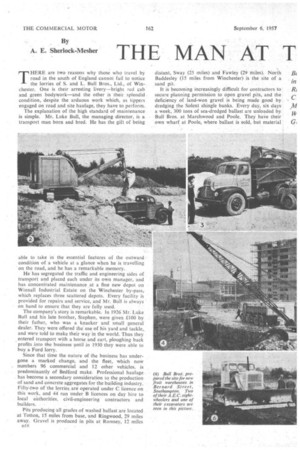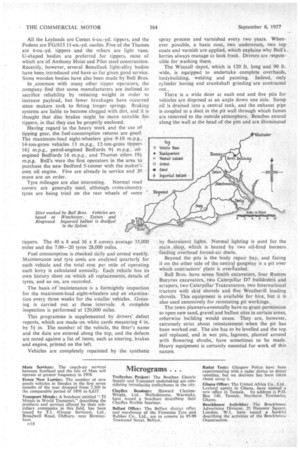A. E. Sherlock-Mesher THE MAN AT T T HERE are two
Page 62

Page 63

Page 64

If you've noticed an error in this article please click here to report it so we can fix it.
reasons why those who travel by road in the south of England cannot fail to notice the lorries of S. and L. Bull Bros., Ltd., of Winchester. One is their arresting livery—bright red cab and. green bodywork—and the other is their splendid. condition, despite the arduous work which, as tippers engaged on road and site haulage, they have to perform._
The explanation of the high standard of maintenance is simple. Mr. Luke Bull, the managing director, is a transport man born and bred. He has the gift of being able to take in the essential features of the outward condition of a vehicle at a glance when he is travelling on the road, and he has a remarkable memory.
He has segregated the traffic and engineering sides of transport and placed each under its own manager, and has concentrated maintenance at a fine new depot on Winnall Industrial Estate on the Winchester by-pass, which replaces three scattered depots. Every facility is provided for repairs and service, and Mr. Bull is always on hand to ensure that they are fully used.
The company's story is remarkable. In 1926 Mr. Luke Bull and his late brother, Stephen, were .given £100 by their father, who was a knacker and' small general dealer. They were offered the use of his yard and tackle,. and were told to make their way in the world. Thus they entered transport with a horse and cart, ploughing back profits Into the business until in 1930 they were able to buy .a Ford lorry.
Since that time the nature of the business has undergone a marked change, and the fleet, which now numbers 96 commercial and 12 other vehicles, is predominantly of Bedford make. Professional haulage has become a secondary consideration to the production of sand and concrete aggregates for the building industry. Fifty-two of the lorries are operated under C. licence on this work, and 44 run under B licences on day hire to local authorities, civil-engineering contractors and builders. • Pits producing all grades of washed ballast are located at Totton, 15 miles from base, and Ringwood, 29 miles away. Gravel is produced in pits at Ramsey, 12 miles nt 6 distant, Sway (25 miles) and Fawley (29 miles). North Baddesley (15 miles from Winchester) is the site of a sand pit.
It is becoming increasingly difficult for contractors to secure planning permission to open gravel pits, and the deficiency of land-won gravel is being made good by dredging the Solent shingle banks. Every day, six days a week, 300 tons of sea-dredged ballast are unloaded by Bull Bros. at Marchwood and Poole. They have their own wharf at Poole, where ballast is sold, but material delivered to Marchwood has to he loaded by crane into lorries and taken to Tottort for subsequent sale.
There 12 vehicles are based, whilst 29 are stationed at Ringwood, The remainder operate from Winchester. The company serve the whole of Hampshire, East Dorset, South Wiltshire, and parts of Berkshire and East Sussex, but are prepared to go • anywhere in Southern England.
Daily sale's average 2,000 cu. yd, of sand and ballast. Ballasi is loaded from overhead hoppers and sand by excavator of mechanical shovel. Business maintains a fairly steady level throughout the year, the absence of long, severe winter frost in the south of England assisting in this direction., Orders ate normally received in the late afternoon for execution next day, but the company try to give service at an hour's notice. During my visit I was able to 'observe that this is no idle boast.
The fleet, which Iasi year covered 2848,356 miles, comprises 43 Bedford, 29 A.E.C., 12 Leyland, 8 Thames and ;,4 Foden commercial vehicles, apart from cars and motorcycles. Nine of the Bedfords are 4-cu.-yd. tippers, 30 are 5-cu.-yd, models, 2 are 30-cwtr. and 2 are 10-cwt. vans. A.E.C. are represented by 13 Monarch 6-cu.-yd. tippers, 11 Mammoth Major 11-12-cu.-yd. models, 2 Monarch and 2 Mammoth pit lorries and a Matador low-loader: All the Leylands are Cornet 6-cu.-yd. tippers, and the Fodens are FG/615 11-cu.-yd. outfits. Five of the Thames are 4-cu.-yd, tippers and the others are light vans. U-shaped bodies are preferred for tippers, most of which are of Anthony Hoist and Pilot steel construction. Recently, however, several BonaHack light-alloy bodies have been introduced and have so far given good service. Some wooden bodies have also been made by Bull Bros.
In ,common with many other tipper operators, the company find that some manufacturers are inclined to sacrifice reliability by reducing weight in order to increase payload, but fewer breakages have occurred since makers took to fitting longer springs. Braking systems are liable to become clogged with dirt, and it is thought that disc brakes might be more suitable fon tippers, in that they can be properly enclosed.
Having regard to the heavy work and the use of tipping gear, the fuel-consumption returns are good. The maximum-load eight-wheelers give 9-10 m.p.g., 14-ton-gross vehicles 13 m.p.g., I2-ton-gross tippers
164 m.p.g., petrolengined Bedfords m.p.g., oilengined Bedfords 16 m.p.g., and Thames oilers 194 m.p.g. Bull's were the first operators in the area to purchase the new Bedford 5-tonner with the maker's own oil engine. Five are already in service and 20 . more are on order.
Tyre mileages are also interesting. Normal road covers are generally used, although cross-country tyres are being tried on the rear wheels of some tippers. The 40 x 8 and 36 x 8 covers average 35,000 miles and the 7.00-20 tyres 28,000 mites.
Fuel consumption is checked daily and costed weekly. Maintenance and tyre costs are analysed quarterly for each Vehicle and the total cost per Mile of operating each lorry is calculated annually: Each vehicle has its own history sheet On 'which all replacements, details of tyres, and :so on, are recorded.
The basis or maintenance is a fortnightly inspection for the maximum-load eight-wheelers and art examination every three weeks for the smaller vehicles. Greasing is carried out at these intervals. A complete inspection is performed at 120,000 miles.
This programme is supplemented by drivers' defect reports, which are made on white cards measuring 4'in. by 54 in. The number of the vehicle, the fitter's name and the date are entered along the top, and the defects are noted against a list of items, such as steering, brakes and engine, printed on the left.
Vehicles are completely repainted by the synthetic spray process and varnished every two years. Whenever possible, a• basic coat, two undercoats, two top coats and varnish are applied, which explains why Bull's_ lorries always manage to look fresh. Drivers are responsible for washing them.
The Winnall depot, which is 120 ft. long and 90 ft. wide, is equipped to undertake complete overhauls, • bodybuilding, welding and painting. Indeed, only cylinder boring and crankshaft grinding are contracted out..
There is a wide door at each end and five pits for vehicles are disposed at an angle down one Side. Sump oil is drained into a central tank, and the exhaust pipe is coupled to a duct in the pit wall through which fumes are removed to the outside atmosphere. Benches extend along the wall at the head of the pits and are illuminated
by fluorescent .lights. Normal lighting is used for the main shop, Which is heated by two oil-fired burners feeding overhead forced-air ducts.
Beyond the pits is the body repair bay,. and facing it on the other side of the central gangway is a pit over which contractors' plant is oveAauled.
Bull Bros. have seven Smith excavators, four Ruston Bucyrus excavators, two Caterpillar D7 bulldozers and scrapers, two Caterpillar Traxcavators, two International tractors with skid shovels and five Weatherill loading shovels. This equipment is available for hire, but it is also used extensively for reinstating pit workings.
The town planners-eventually have to grant permission to open new sand, gravel and ballast sites in certain areas, otherwise building would cease. They are, however, extremely strict about reinstatement when the pit has been worked out. The site has to be levelled and the top soil replaced, and in wet pits, lagoons, planted around with flowering shrubs, have sometimes to be made. Heavy equipment is certainly essential for work of this nature.




























































































































